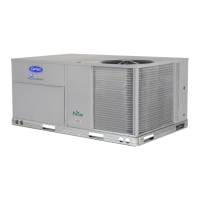52
Filter Status Switch —
This function is available only when the PremierLinkt
controller is configured for (Space) Sensor Mode.
PremierLink controller can monitor return filter status in
two ways: By monitoring a field --supplied/installed filter
pressure switch or via supply fan runtime hours.
Using switch input: Install the dirty filter pressure switch
according to switch manufacturer’s instructions, to
measure pressure drop across the unit’s return filters.
Connect one side of the switch’s NO contact set to CTB’s
THERMOSTAT--R terminal. Connect the other side of the
NO contact set to TB1--10. Setpoint for Dirty Filter is set
at the switch. See Fig. 64.
R
TB1
J4-4
PL
Filter Switch (NO, close on rising pressure (high drop))
CTB
Thermostat
10
C08216
Fig. 64 -- PremierLink Controller Filter Switch
Connection
When the filter switch’s NO contact set closes as filter
pressure drop increases (indicating dirt --laden filters), the
input signal to PremierLink controller causes the filter
status point to read “DIRTY”.
Using Filter Timer Hours: Refer to the PremierLink
t
Control ler Installation, Start--up, and Configuration
Instructions for instructions on using the PremierLink
Configuration screens and on unit a larm sequence.
Supply Fan Status Switch —
The PremierLink c ontroller can monitor supply fa n
operation through a field--supplied/installed differential
pressure switch. This sequence will prevent (or interrupt)
operat ion of unit cooling, heating and economizer
functions until the pressure switch contacts are closed
indicating proper supply fan operation.
Install the different ial pressure switch in the supply fan
section according to switch manufacturer ’s instructions.
Arrange the switch contact to be open on no flow and to
close as pressure rises indicating fan operation.
Connect one side of the switch’s NO contact set to CTB’s
THERMOSTAT--R terminal. Connect the other side of the
NO conta ct set to TB1--8. Setpoint for Supply Fan Status
is set at the switch. See Fig. 65.
R
8
TB1
J4-6
PL
Fan (Pressure) Switch (NO, close on rise in pressure)
CTB
Thermostat
C08118
Fig. 65 -- PremierL in k Co n troller Wiring Fan Pressu re
Sw it ch Co n n ectio n
Remote Occupied Switch —
The PremierLink controller permits a remote timeclock to
override the control’s on--board occupancy schedule a nd
plac e the unit into Occupied mode. This function may also
provide a “Door Switch” time delay function that will
terminate cooling and heating functions after a 2 to 20
minute delay.
Connect one side of the NO contact set on the timeclock
to CTB’s THERMOSTAT--R terminal. Connect the other
side of the timeclock contact to the unit’s TB1 --2 terminal
(see Fig. 66).
R
2
TB1
PL
Time Clock
Remote Occupied
CTB
Thermostat
J4-12
C08214
Fig. 66 -- PremierLink Controller Wiring
Remote Occupied
Refer to the PremierLink
t
Controller Installation,
Start--up, and Configuration Instructions for additional
information on configuring the PremierLink controller for
Door Switch timer function.
Power Exhaust (output) —
Connect the accessory Power Exhaust contactor coils(s)
per Fig. 67.
J8-3
15
C
TB1
PL
PEC
TAN
GRA
Power Exhaust
CTB
THERMOSTAT
C08120
Fig. 67 -- PremierLink Power Exhaust Output
Connection
NOTE: The Power Exhaust and Humidi--MiZer
R
system
options cannot be used with PremierLink at the same time
as both options require connection at TB1--15 (AUX
OUT).
CCN Communication Bus —
The PremierLink controller connects to the bus in a daisy
chain arrangement. Negative pins on each component
must be connected to respective negative pins, and
likewise, positive pins on each component must be
connected to respective positive pins. The controller
signal pins must be wired to the signal ground pins.
Wiring connections for CCN m ust be made at the 3--pin
plug.
At any baud (9600, 19200, 38400 baud), the number of
controllers is limited to 239 devices maximum. Bus length
may not exceed 4000 ft, with no more than 60 total
devic es on any 1000--ft section. Optically isolated RS--485
repea ters are re quired every 1000 ft.
NOTE: Carrier device default is 9600 baud.

